فهرست میراث جهانی یونسکو در کشورهای عربی
این فهرست میراث جهانی یونسکو در کشورهای عربی است.[1] برخی از این کشورها از نظر جغرافیایی در آسیا و برخی در آفریقا واقع شدهاست. میراث جهانی یونسکو نام عهدنامهای بینالمللی است که در تاریخ ۱۶ نوامبر ۱۹۷۲ میلادی به تصویب کنفرانس عمومی یونسکو رسید. موضوع آن حفظ آثار تاریخی، طبیعی و فرهنگی بشر است که اهمیت جهانی دارند و متعلق به تمام انسانهای زمین، فارغ از نژاد، مذهب و ملیت خاص، میباشند.[2] اتحادیهٔ عرب یک سازمان جهانی منطقهای شامل کشورهای بیشتر عربیِ جنوب غرب آسیا و شمال آفریقا است. این سازمان در ۲۲ مارس ۱۹۴۵ با ۶ عضو نهادگر مصر، عربستان، عراق، سوریه، لبنان، و فرااردن (که در ۱۹۴۶ به اردن تغییر نام داد) بنیان نهاده شد. این فهرست شامل میراث کشورهای عضو اتحادیهٔ عرب میشود.


فهرست
| نگاره | سایت | مکان | معیارها | مساحت (هکتار) | موقعیت | سال | توضیحات |
|---|---|---|---|---|---|---|---|
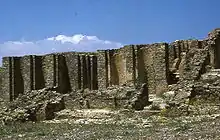 | دژ بنی حماد | استان مسیله، | فرهنگی: (iii) | ۱۵۰ | ۳۷۰ | ۱۹۸۰ | این آثار که در منطقهای کوهستانی با چشمانداز بسیار استثنایی واقع شدهاند، ویرانههای نخستین پایتخت امیران فرمانروایی بنی حمادها را شامل میشوند. ساخته شده در سال ۱۰۰۷ و نابود شده در ۱۱۵۲، این آثار تصاویری روشن و بدیع را از شهری دژگونه و مسلماننشین ارائه میدهند.[3] |
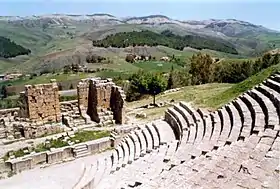 | جمیله | استان ستیف، | فرهنگی: (iii)(iv) | ۳۱ | ۷۷ | ۱۹۸۲ | قرار گرفته در ارتفاع ۹۰۰ متری از سطح دریا، جمیله یا کوییکول با همهٔ سازهها، معابد، تاقهای پیروزی و خانههایش نمونهای جالب از شهرسازی رومی طراحی شده برای محیط کوهستانی را به تصویر میکشد.[4] |
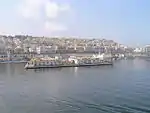 | کسبه | استان الجزایر، | فرهنگی: (ii)(v) | ۵۰ | ۱۲۰ | ۱۹۸۲ | کسبه نمونه تکی از یک مدینهٔ فاضله یا همان شهر اسلامی است. این شهر، که در یکی از بهترین کرانههای دریای مدیترانه قرار گرفته، چشماندازی به جزیرههایی در این دریا دارد که روزگاری در سده ۴ام میلادی بازارچههای تجاری کارتاژها را در خود جای میدادند.[5] |
 | دره مزاب | استان غردایه، | فرهنگی: (ii)(iii)(v) | ۴٬۰۰۰ | ۹٬۹۰۰ | ۱۹۸۲ | آثار سنتی از زیستگاههای کهن انسانها، که در سده دهم میلادی توسط اباضیان به دور پنج شهر باروبندیشدهشان (با نام قصور) کشیده شد، بدون آسیبدیدگی در دره مزاب باقی ماندهاند.[6] |
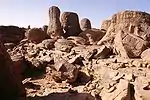 | طسیلی ناجر | استان الیزی and استان تمنراست، | ترکیبی: (i)(iii)(vii)(viii) | ۷٬۲۰۰٬۰۰۰ | ۱۸٬۰۰۰٬۰۰۰ | ۱۹۸۲ | این مکان یکی از مهمترین گروه غارهایی در جهان را دربر گرفته که هنر نقاشی در غار در آنها وجود دارد. بیش از ۱۵٬۰۰۰ نگاره و سنگتراشی چگونگی تغییرات آب و هوایی، مهاجرت جانداران، و فرگشت زندگی انسانهای ساکن پیرامون منطقه صحرا را از ۶۰۰۰ سال پیش از میلاد تا نخستین سدههای دوران کنونی به تصویر کشیدهاند.[7] |
%252C_Algeria_04966r.jpg.webp) | تیمگد | استان باتنه، | فرهنگی: (ii)(iii)(iv) | ۹۱ | ۲۲۰ | ۱۹۸۲ | تیمگد در کنارههای شمالی کوههای اورس جای گرفته و در آغاز به عنوان یک مستعمره امپراتور تراژان در ۱۰۰ پس از میلاد مورد استفاده قرار میگرفت.[8] |
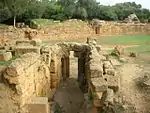 | تیپازه | استان تیپازه، | فرهنگی: (iii)(iv) | ۵۲ | ۱۳۰ | ۱۹۸۲ |
تیپازه در گذشته شهرکی تجاری برای داد و ستد بود که توسط روم فتح شد و تبدیل به پایگاهی راهبردی برای فتح پادشاهیهای موریتانی گشت. این شهر شامل ویرانههایی منحصر به فرد از فینیقیان، رومیان، نومسیحیان، و بیزانسیان در کنار تندیسهای بومیای چون کبور ار رومیا (Kbor er Roumia)، آرامگاه بزرگ شاهانه موریتانی، است.[9] |
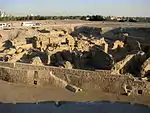 | قلعه بحرین – Ancient Harbour and Capital of Dilmun | استان شمالی (بحرین), | فرهنگی: (ii)(iii)(iv) | ۳۲ | ۷۹ | ۲۰۰۵ | این مکان پایتخت دیلمون، یکی از مهمترین تمدنهای منطقه، بودهاست.[10] |
| ابو مینا | استان اسکندریه، | فرهنگی: (iv) | ۱۸۳ | ۴۵۰ | ۱۹۷۹ | The church, baptistry, basilicas, public buildings, streets, monasteries, houses and workshops in this early Christian holy city were built over the tomb of the martyr Menas of Alexandria, who died in A.D. 296.[11] | |
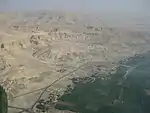 | Ancient تبس with its Necropolis | استان اقصر، | فرهنگی: (i)(iii)(vi) | ۷٬۳۹۰ | ۱۸٬۳۰۰ | ۱۹۷۹ | Thebes, the city of the god Amon, was the capital of Egypt during the period of the Middle and New Kingdoms.[12] |
.jpg.webp) | Historic Cairo | استان قاهره، | فرهنگی: (i)(v)(vi) | ۵۲۴ | ۱٬۲۹۰ | ۱۹۷۹ | Tucked away amid the modern urban area of Cairo lies one of the world's oldest Islamic cities, with its famous mosques, madrasas, hammams and fountains. Founded in the 10th century, it became the new centre of the Islamic world, reaching its golden age in the 14th century.[13] |
 | ممفیس (مصر باستان) and its مجموعه اهرام جیزه | استان جیزه، | فرهنگی: (i)(iii)(vi) | ۱۶٬۳۵۹ | ۴۰٬۴۲۰ | ۱۹۷۹ | The capital of the Old Kingdom of Egypt has some extraordinary funerary monuments, including rock tombs, ornate mastabas, temples and pyramids. In ancient times, the site was considered one of the Seven Wonders of the World.[14] |
 | ابو سیمبل | استان اسوان، | فرهنگی: (i)(iii)(vi) | ۳۷۴ | ۹۲۰ | ۱۹۷۹ | This outstanding archaeological area contains such magnificent monuments as the Temples of Ramses II at Abu Simbel and the Sanctuary of Isis at Philae, which were saved from the rising waters of the Nile thanks to the International Campaign launched by UNESCO, in 1960 to 1980.[15] |
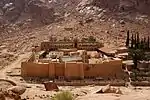 | صومعه سنت کاترین | استان سینای جنوبی، | فرهنگی: (i)(iii)(iv)(vi) | ۶۰٬۱۰۰ | ۱۴۹٬۰۰۰ | ۲۰۰۲ | The Orthodox Monastery of St Catherine stands at the foot of Mount Horeb where, the Old Testament records, Moses received the Tablets of the Law. The mountain is known and revered by Muslims as Jebel Musa. The entire area is sacred to three world religions: Christianity, Islam, and Judaism.[16] |
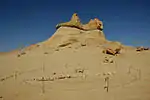 | Wadi Al-Hitan (Whale Valley) | استان فیوم، | طبیعی: (viii) | ۲۰٬۰۱۵ | ۴۹٬۴۶۰ | ۲۰۰۵ | Located in a desert, the site contains fossil remains of the now extinct کهنآببازسانان، a suborder of whales, showing the evolution of the whales from a land-based to a aquatic mammal.[17] |
| — | Ashur (Qal'at Sherqat) | استان صلاحالدین، | فرهنگی: (iii)(iv) | ۷۰ | ۱۷۰ | ۲۰۰۳ | The ancient city of Ashur is located on the Tigris River in northern Mesopotamia. The city dates back to the 3rd millennium BC. From the 14th to the 9th centuries BC it was the first capital of the Assyrian Empire. The city was destroyed by the Babylonians, but revived during the Parthian period in the 1st and 2nd centuries AD.[18] |
 | هترا | استان نینوا، | فرهنگی: (ii)(iii)(iv)(vi) | ۳۲۴ | ۸۰۰ | ۱۹۸۵ | A large fortified city under the influence of the Parthian Empire and capital of the first Arab Kingdom, Hatra withstood invasions by the Romans in A.D. 116 and 198 thanks to its high, thick walls reinforced by towers.[19] |
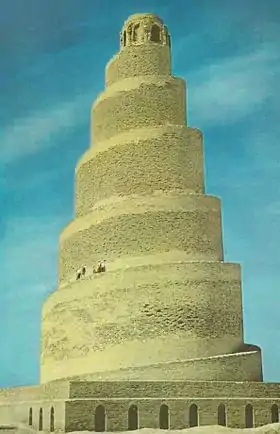 | سامرا Archaeological City | استان صلاحالدین، | فرهنگی: (ii)(iii)(iv) | ۱۵٬۰۵۸ | ۳۷٬۲۱۰ | ۱۹۸۵ | Samarra Archaeological City is the site of a powerful Islamic capital city that ruled over the provinces of the Abbasid Empire extending from Tunisia to Central Asia for a century. The 9th-century Great Mosque and its spiral minaret are among the numerous remarkable architectural monuments of the site, 80% of which remain to be excavated.[20] |
.jpg.webp) | The Old City of Jerusalem and its Walls | اورشلیم، | فرهنگی: (ii)(iii)(vi) | — | — | ۱۹۸۵ | As a holy city for Judaism, Christianity and Islam, Jerusalem has always been of great symbolic importance. It is recognized by all three religions as the site of Abraham's sacrifice. The Wailing Wall delimits the quarters of the different religious communities, while the Resurrection rotunda in the Church of the Holy Sepulchre houses Christ's tomb.[21] |
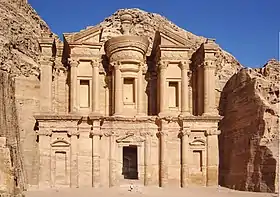 | پترا | استان معان، | فرهنگی: (i)(iii)(iv) | — | — | ۱۹۸۵ | Inhabited since prehistoric times, this Nabataean caravan-city, situated between the Red Sea and the Dead Sea, was an important crossroads between Arabia, Egypt and Syria-Phoenicia. Petra is half-built, half-carved into the rock, and is surrounded by mountains riddled with passages and gorges.[22] |
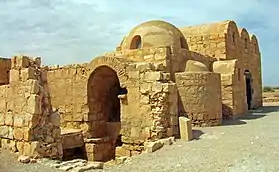 | قصرامرا | زرقاء (استان), | فرهنگی: (i)(iii)(iv) | — | — | ۱۹۸۵ | Built in the early 8th century, this exceptionally well-preserved desert castle was both a fortress with a garrison and a residence of the Umayyad caliphs.[23] |
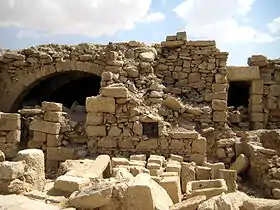 | امارصاص (Kastrom Mefa'a) | استان مادبا، | فرهنگی: (i)(iv)(vi) | ۲۴ | ۵۹ | ۲۰۰۵ | Most of this archaeological site, which started as a Roman military camp and grew to become a town from the 5th century, has not been excavated. It contains remains from the Roman, Byzantine and Early Muslim periods (end of 3rd to 9th centuries AD) and a fortified Roman military camp.[24] |
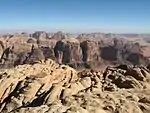 | وادی رم Protected Area | استان فیوم، | ترکیبی: (iii)(v)(vii) | ۷۴٬۱۸۰ | ۱۸۳٬۳۰۰ | ۲۰۰۵ | The 74,000-hectare property, inscribed as a mixed natural and cultural site, is situated in southern Jordan, near the border with Saudi Arabia. It features a varied desert landscape, as well as 25,000 rock carvings with 20,000 inscriptions trace the evolution of human thought and the early development of the alphabet.[25] |
 | Anjar | استان بقاع، | فرهنگی: (iii)(iv) | — | — | ۱۹۸۴ | The city of Anjar was founded by Caliph Walid I at the beginning of the 8th century. The ruins reveal a very regular layout, reminiscent of the palace-cities of ancient times, and are a unique testimony to city planning under the Umayyads.[26] |
 | بعلبک | استان بقاع، | فرهنگی: (i)(iv) | — | — | ۱۹۸۴ | Baalbek, where a triad of deities was worshipped, was known as Heliopolis during the Hellenistic period. It retained its religious function during Roman times, when the sanctuary of the Heliopolitan Jupiter attracted thousands of pilgrims.[27] |
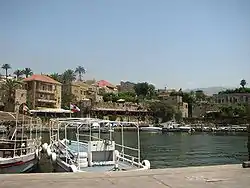 | جبییل | استان جبل لبنان، | فرهنگی: (iii)(iv)(vi) | — | — | ۱۹۸۴ | The ruins of many successive civilizations are found at Byblos, one of the oldest Phoenician cities. Inhabited since Neolithic times, it has been closely linked to the legends and history of the Mediterranean region for thousands of years.[28] |
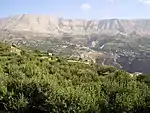 | Ouadi Qadisha (the Holy Valley) and the Forest of the Cedars of God (Horsh Arz el-Rab) | استان شمالی لبنان، | فرهنگی: (iii)(iv) | — | — | ۱۹۹۸ | The Qadisha valley is one of the most important early Christian monastic settlements in the world. Nearby are the remains of the great forest of cedars of Lebanon, highly prized in antiquity for the construction of great religious buildings.[29] |
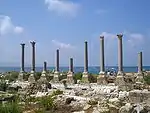 | صور (لبنان) | استان جنوبی لبنان، | فرهنگی: (iii)(vi) | ۱۵۴ | ۳۸۰ | ۱۹۸۴ | Tyre ruled the seas and founded prosperous colonies such as Cadiz and Carthage, but its historical role declined at the end of the Crusades. There are important archaeological remains, mainly from Roman times.[30] |
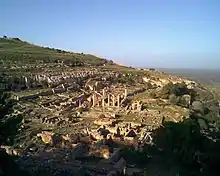 | Archaeological Site of Cyrene | Al Jabal al Akhdar, | فرهنگی: (ii)(iii)(vi) | — | — | ۱۹۸۲ | A colony of the Greeks of Thera, Cyrene was one of the principal cities in the Hellenic world. It was Romanized and remained a great capital until the earthquake of 365. A thousand years of history is written into its ruins, which have been famous since the 18th century.[31] |
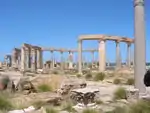 | Archaeological Site of Leptis Magna | خمس، | فرهنگی: (i)(ii)(iii) | — | — | ۱۹۸۲ | Leptis Magna was enlarged and embellished by Septimius Severus, who was born there and later became emperor. It was one of the most beautiful cities of the Roman Empire, with its imposing public monuments, harbour, market-place, storehouses, shops and residential districts.[32] |
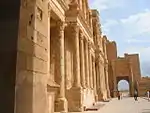 | Archaeological Site of Sabratha | استان زاویه، | فرهنگی: (iii) | — | — | ۱۹۸۲ | A Phoenician trading-post that served as an outlet for the products of the African hinterland, Sabratha was part of the short-lived Numidian Kingdom of Massinissa before being Romanized and rebuilt in the 2nd and 3rd centuries A.D.[33] |
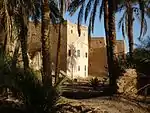 | غدامس | استان نالوت، | فرهنگی: (v) | — | — | ۱۹۸۶ | Ghadamès, known as 'the pearl of the desert', stands in an oasis. It is one of the oldest pre-Saharan cities and an outstanding example of a traditional settlement.[34] |
 | محوطهٔ سنگنگارههای تدرارت اکاکوس | فزان، | فرهنگی: (iii) | — | — | ۱۹۸۵ | The rocky massif has thousands of cave paintings in very different styles, dating from 12,000 BCE to 100 CE.[35] |
 | Ancient Ksour of Ouadane, Chinguetti, Tichitt and Oualata | Ouadane, Chinguetti, Tichitt, and Oualata, | فرهنگی: (iii)(iv)(v) | — | — | ۱۹۹۶ | Founded in the 11th and 12th centuries to serve the caravans crossing the Sahara, these trading and religious centres became focal points of Islamic culture. They have managed to preserve an urban fabric that evolved between the 12th and 16th centuries.[36] |
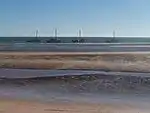 | Banc d'Arguin National Park | نوادیبو and Azefal, | طبیعی: (ix)(x) | ۱٬۲۰۰٬۰۰۰ | ۳٬۰۰۰٬۰۰۰ | ۱۹۸۹ | The park consists of ریگروانs, coastal swamps, small islands, and shallow bodies of water, all bordering the coast of the Atlantic Ocean. Birds are often found to migrate in the area, accompanied by various species of sea turtles and dolphins, whose presence fishermen often use to attract fish.[37] |
 | ولیلی | مکناس تافیلالت، | فرهنگی: (ii)(iii)(iv)(vi) | ۴۲ | ۱۰۰ | ۱۹۹۷ | The important روم باستان outpost of Volubilis was founded in the 3rd century BCE to become the capital of موریتانی. It contained many buildings, the remains of which have survived extensively to this day.[38] |
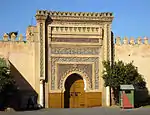 | مکناس | مکناس تافیلالت، | فرهنگی: (iv) | — | — | ۱۹۹۶ | The former capital was founded in the 11th century and turned into an impressive city in Spanish-Moorish style during the 17th and 18th centuries.[39] |
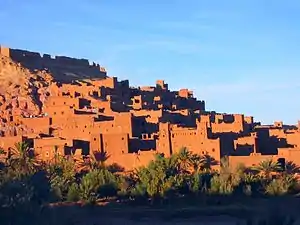 | آیت بن حدو | سوس ماسه درعه، | فرهنگی: (iv)(v) | ۳ | ۷٫۴ | ۱۹۸۷ | The ksar is a group of earthen building surrounded by high walls, a traditional pre-Saharan habitat.[40] |
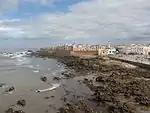 | صویره | مراکش تانسیفت الحوز، | فرهنگی: (ii)(iv) | ۳۰ | ۷۴ | ۲۰۰۱ | The fortified seaport built during the late 18th century has a mix of North African and European architecture, and been a major trading hub between Sahara and Europe.[41] |
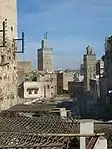 | فاس | Fez, | فرهنگی: (ii)(v) | ۲۸۰ | ۶۹۰ | ۱۹۸۱ | The former capital was founded in the 9th century and features the world's oldest university. The urban fabric and principal monuments date from the 13th and 14th centuries.[42] |
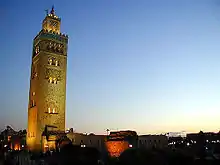 | مراکش | مراکش تانسیفت الحوز، | فرهنگی: (i)(ii)(iv)(v) | ۱٬۱۰۷ | ۲٬۷۴۰ | ۱۹۸۵ | The town was founded in the 1070s and remained a political, economic and cultural center for a long time. Monuments from that period include the Koutoubia Mosque, the kasbah and the battlements. The city also has newer architectural jewels, including palaces.[43] |
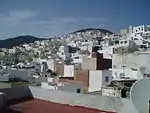 | تطوان | طنجه تطوان، | Cultural: (ii)(iv)(v) | ۷ | ۱۷ | ۱۹۹۷ | Morocco's most complete medina served as the main point of contact between Morocco and اندلس during the 8th century. After the سقوط آندلس، the town was rebuilt by Andalusian refugees.[44] |
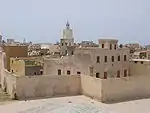 | الجدیده | دکاله عبده، | فرهنگی: (ii)(iv) | ۸ | ۲۰ | ۲۰۰۴ | The fortification was built in رنسانس military design in the early 16th century, and taken over by Morocco in 1769. Surviving Portugese buildings include the cistern and a معماری گوتیک church.[45] |
| — | Aflaj Irrigation Systems of Oman | منطقه شرقیه and باطنه Regions, | فرهنگی: (v) | ۱٬۴۵۶ | ۳٬۶۰۰ | ۲۰۰۶ | The property includes five aflaj irrigation systems and is representative of some 3,000 such systems still in use in Oman. The origins of this system of irrigation may date back to AD 500, but archaeological evidence suggests that irrigation systems existed in this extremely arid area as early as 2500 BC.[46] |
| — | Archaeological Sites of Bat, Al-Khutm and Al-Ayn | استان ظاهره، | فرهنگی: (iii)(iv) | — | — | ۱۹۸۸ | The protohistoric site of Bat lies near a palm grove in the interior of the Sultanate of Oman. Together with the neighbouring sites, it forms the most complete collection of settlements and necropolises from the 3rd millennium B.C. in the world.[47] |
| — | Land of Frankincense | استان ظفار، | فرهنگی: (iii)(iv) | ۸۵۰ | ۲٬۱۰۰ | ۲۰۰۰ | The frankincense trees of Wadi Dawkah and the remains of the caravan oasis of Shisr/Wubar and the affiliated ports of Khor Rori and Al-Baleed vividly illustrate the trade in frankincense that flourished in this region for many centuries, as one of the most important trading activities of the ancient and medieval world.[48] |
| مداین صالح | استان مدینه، | فرهنگی: (ii)(iii) | ۱٬۶۲۱ | ۴٬۰۱۰ | ۲۰۰۸ | Formerly known as Hegra it is the largest conserved site of the civilization of the Nabataeans south of Petra in Jordan. It features well-preserved monumental tombs with decorated facades dating from the 1st century BC to the 1st century AD.[49] | |
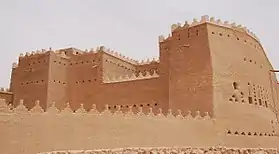 | درعیه | استان ریاض، | فرهنگی: (ii)(iii) | ۲۹ | ۷۲ | ۲۰۰۸ | Diriyah was the first capital of the Saudi Dynasty, in the heart of the Arabian Penisula, north-west of Riyadh. It includes the remains of many palaces and an urban ensemble built on the edge of the ad-Dir’iyah oasis.[50] |
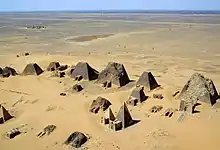 | Archaeological Sites of the Island of Meroe | River Nile State, | فرهنگی: (ii)(iii)(iv)(v) | ۲٬۳۵۷ | ۵٬۸۲۰ | ۲۰۱۱ | The site, a semi-desert landscape between the Nile and Atbara rivers, was the heartland of the Kingdom of Kush, a major power from the 8th century B.C. to the 4th century A.D.[51] |
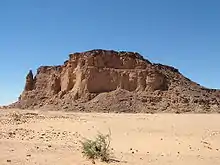 | Gebel Barkal and the Sites of the Napatan Region | Northern State, | فرهنگی: (i)(ii)(iii)(iv)(vi) | ۱۸۳ | ۴۵۰ | ۲۰۰۳ | The five sites in the نیل feature temples that are a testimony to the Napatan (900–270 BCE) and Meroitic (270 BCE – 350 CE) cultures.[52] |
.jpg.webp) | حلب | استان حلب، | فرهنگی: (iii)(iv) | — | — | ۱۹۸۶ | Located at the crossroads of several trade routes from the 2nd millennium B.C. , Aleppo was ruled successively by the Hittites, Assyrians, Arabs, Mongols, Mamelukes and Ottomans.[53] |
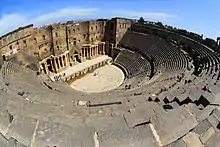 | بصری | استان درعا، | فرهنگی: (i)(iii)(vi) | — | — | ۱۹۸۰ | Bosra, once the capital of the Roman province of Arabia, was an important stopover on the ancient caravan route to Mecca. A magnificent 2nd-century Roman theatre, early Christian ruins and several mosques are found within its great walls.[54] |
 | دمشق | استان دمشق، | فرهنگی: (i)(ii)(iii)(iv)(vi) | ۸۶ | ۲۱۰ | ۱۹۷۹ | Founded in the 3rd millennium B.C. , Damascus is one of the oldest cities in the Middle East. In the Middle Ages, it was the centre of a flourishing craft industry, specializing in swords and lace.[55] |
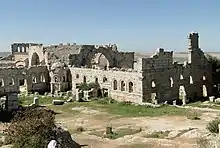 | Ancient Villages of Northern Syria | فرهنگی: (iii)(iv)(v) | ۱۲٬۲۹۰ | ۳۰٬۴۰۰ | ۲۰۱۱ | Some 40 villages grouped in eight parks situated in north-western Syria provide remarkable testimony to rural life in late Antiquity and during the Byzantine period.[56] | |
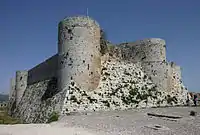 | دژ کردان and قلعه صلاحالدین ایوبی | استان حمص and استان لاذقیه Governorates, | فرهنگی: (ii)(iv) | ۹ | ۲۲ | ۲۰۰۶ | These two castles represent the most significant examples illustrating the exchange of influences and documenting the evolution of fortified architecture in the Near East during the time of the Crusades (11th - 13th centuries).[57] |
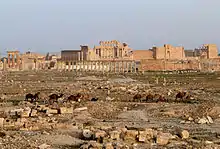 | پالمیرا | استان حمص، | فرهنگی: (i)(ii)(iv) | ۰٫۳۶ | ۰٫۸۹ | ۱۹۸۰ | An oasis in the Syrian desert, north-east of Damascus, Palmyra contains the monumental ruins of a great city that was one of the most important cultural centres of the ancient world.[58] |
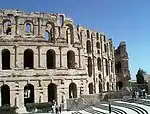 | Amphitheatre of El Jem | استان مهدیه، | فرهنگی: (iv)(vi) | ۱٫۳۷ | ۳٫۴ | ۱۹۷۹ | The Amphitheatre of El Jem, built during the 3rd century, is North Africa's largest coliseum with a capacity of 35,000 spectators, and "illustrates the grandeur and extent of Imperial Rome."[59] |
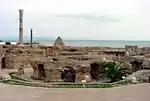 | کارتاژ | استان تونس، | فرهنگی: (ii)(iii)(vi) | — | — | ۱۹۷۹ | Founded in the 9th century BCE, Carthage was developed into a trading empire spanning the مدیترانه، and was, according to UNESCO, "home to a brilliant civilization." The city was destroyed in 146 BCE in the جنگهای پونیک at the hands of the Romans, but was later rebuilt by these.[60] |
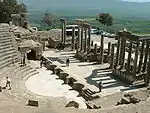 | Dougga / Thugga | استان باجه، | فرهنگی: (ii)(iii) | ۷۰ | ۱۷۰ | ۱۹۹۷ | The site features the ruins of Dougga, a former capital of a لیبی–Punic state, which flourished under روم باستان and the امپراتوری روم شرقی، but declined in the Islamic period.[61] |
 | دریاچه اشکل | استان بنزرت، | طبیعی: (x) | ۱۲٬۶۰۰ | ۳۱٬۰۰۰ | ۱۹۸۰ | دریاچه اشکل and the surrounding wetlands is a major stopover for hundreds of thousands of migrating bird, including اردکs, غاز، لکلکs and فلامینگوs. Ichkeul is the last remaining lake in a chain that once extended across North Africa.[62] |
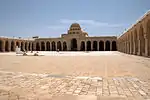 | قیروان | استان قیروان، | فرهنگی: (i)(ii)(iii)(v)(vi) | ۶۸ | ۱۷۰ | ۱۹۸۸ | The city was founded in 670 and flourished as a capital in the 9th century. Its heritage includes the مسجد جامع قیروان and the Mosque of the Three Gates.[63] |
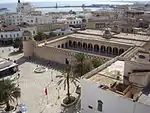 | سوسه | استان سوسه، | فرهنگی: (iii)(iv)(v) | ۳۲ | ۷۹ | ۱۹۸۸ | The city was an important commercial and military port during the 9th century and a typical example of a town dating from the first centuries of Islam.[64] |
 | تونس | استان تونس، | فرهنگی: (ii)(iii)(v) | ۲۹۶ | ۷۳۰ | ۱۹۷۹ | The medina contains 700 monuments, including palaces, mosques, mausoleums, مدرسه (روستا) and fourtains, testifying to Tunis golden age from the 12th to the 16th century.[65] |
 | Punic Town of Kerkuane and its Necropolis | استان نابل، | فرهنگی: (iii) | — | — | ۱۹۸۵ | The city was abandoned in 250 BCE during the اولین جنگ کارتاژ، and remains the only example of a فنیقیها–Punic settlement.[66] |
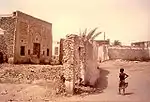 | زبیده | حدیده (استان), | فرهنگی: (iii) | — | — | ۱۹۹۳ | Zabid was the capital of Yemen from the 13th to the 15th century. The city played an important role in the Arab and Muslim world for many centuries because of its Islamic university.[67] |
 | صنعا | Sana Governorate, | فرهنگی: (iv)(v)(vi) | — | — | ۱۹۸۶ | Sana’a has been inhabited for more than 2,500 years. In the 7th and 8th centuries the city became a major centre for the propagation of Islam. This religious and political heritage can be seen in the 103 mosques, 14 hammams and over 6,000 houses, all built before the 11th century.[68] |
 | شبام | حضرموت، | فرهنگی: (iii)(iv)(v) | — | — | ۱۹۸۲ | The 16th-century city of Shibam is one of the oldest and best examples of urban planning based on the principle of vertical construction.[69] |
 | سقطرا | حضرموت، | طبیعی: (x) | ۴۱۰٬۴۶۰ | ۱٬۰۱۴٬۳۰۰ | ۲۰۰۸ | Socotra Archipelago, in the northwest Indian Ocean near the Gulf of Aden, is 250 km long and comprises four islands and two rocky islets which appear as a prolongation of the Horn of Africa. The site is of universal importance because of its biodiversity with rich and distinct flora and fauna.[70] |
منابع
- World Heritage Centre - World Heritage List
- «The World Heritage Convention». UNESCO.
- «دژهای بنی حماد». یونسکو. ۱۷ اوت ۲۰۱۱.
- «جمیله». یونسکو. ۱۷ اوت ۲۰۱۱.
- «کسبهٔ الجزایر». یونسکو. ۱۷ اوت ۲۰۱۱.
- «M'zab Valley». یونسکو. ۱۷ اوت ۲۰۱۱. بایگانیشده از اصلی در ۳ نوامبر ۲۰۱۲. دریافتشده در ۲۵ سپتامبر ۲۰۱۱.
- «Tassili n'Ajjer». یونسکو. ۱۷ اوت ۲۰۱۱.
- «Timgad». یونسکو. ۱۷ اوت ۲۰۱۱.
- «Tipaza». یونسکو. ۱۷ اوت ۲۰۱۱.
- "Qal'at al-Bahrain – Ancient Harbour and Capital of Dilmun". UNESCO. Retrieved 17 Aug 2011.
- "Abu Mena". UNESCO. Retrieved 17 Aug 2011.
- "Ancient Thebes with its Necropolis". UNESCO. Retrieved 17 Aug 2011.
- "Historic Cairo". UNESCO. Retrieved 17 Aug 2011.
- "Memphis and its Necropolis – the Pyramid Fields from Giza to Dahshur". UNESCO. Retrieved 17 Aug 2011.
- "Nubian Monuments from Abu Simbel to Philae". UNESCO. Retrieved 17 Aug 2011.
- "Saint Catherine Area". UNESCO. Retrieved 17 Aug 2011.
- "Wadi Al-Hitan (Whale Valley)". UNESCO. Retrieved 17 Aug 2011.
- "Ashur (Qal'at Sherqat)". UNESCO. Retrieved 17 Aug 2011.
- "Hatra". UNESCO. Retrieved 17 Aug 2011.
- "Samarra Archaeological City". UNESCO. Retrieved 17 Aug 2011.
- "Old City of Jerusalem and its Walls". UNESCO. Retrieved 17 Aug 2011.
- "Petra". UNESCO. Retrieved 17 Aug 2011.
- "Qasr Amra". UNESCO. Retrieved 17 Aug 2011.
- "Um er-Rasas (Kastrom Mefa'a)". UNESCO. Retrieved 17 Aug 2011.
- "Wadi Rum Protected Area". UNESCO. Retrieved 17 Aug 2011.
- "Anjar". UNESCO. Retrieved 17 Aug 2011.
- "Baalbek". UNESCO. Retrieved 17 Aug 2011.
- "Baalbek". UNESCO. Retrieved 17 Aug 2011.
- "Ouadi Qadisha (the Holy Valley) and the Forest of the Cedars of God (Horsh Arz el-Rab)". UNESCO. Retrieved 17 Aug 2011.
- "Tyre". UNESCO. Retrieved 17 Aug 2011.
- "Archaeological Site of Cyrene". UNESCO. Retrieved 17 Aug 2011.
- "Archaeological Site of Leptis Magna". UNESCO. Retrieved 17 Aug 2011.
- "Archaeological Site of Sabratha". UNESCO. Retrieved 17 Aug 2011.
- "Old Town of Ghadamès". UNESCO. Retrieved 17 Aug 2011.
- "Rock-Art Sites of Tadrart Acacus". UNESCO. Retrieved 17 Aug 2011.
- "Ancient Ksour of Ouadane, Chinguetti, Tichitt and Oualata". UNESCO. Retrieved 17 Aug 2011.
- "Banc d'Arguin National Park". UNESCO. Retrieved 17 Aug 2011.
- "Archaeological Site of Volubilis". UNESCO. Retrieved 17 Aug 2011.
- "Historic City of Meknes". UNESCO. Retrieved 17 Aug 2011.
- "Ksar of Ait-Ben-Haddou". UNESCO. Retrieved 17 Aug 2011.
- "Medina of Essaouira (formerly Mogador)". UNESCO. Retrieved 17 Aug 2011.
- "Medina of Fez". UNESCO. Retrieved 17 Aug 2011.
- "Medina of Marrakesh". UNESCO. Retrieved 17 Aug 2011.
- "Medina of Tétouan (formerly known as Titawin)". UNESCO. Retrieved 17 Aug 2011.
- "Portuguese City of Mazagan (El Jadida)". UNESCO. Retrieved 17 Aug 2011.
- "Aflaj Irrigation Systems of Oman". UNESCO. Retrieved 17 Aug 2011.
- "Archaeological Sites of Bat, Al-Khutm and Al-Ayn". UNESCO. Retrieved 17 Aug 2011.
- "Land of Frankincense". UNESCO. Retrieved 17 Aug 2011.
- "Portuguese City of Mazagan (El Jadida)". UNESCO. Retrieved 17 Aug 2011.
- "Portuguese City of Mazagan (El Jadida)". UNESCO. Retrieved 17 Aug 2011.
- "Archaeological Sites of the Island of Meroe". UNESCO. Retrieved 17 Aug 2011.
- "Gebel Barkal and the Sites of the Napatan Region". UNESCO. Retrieved 17 Aug 2011.
- "Ancient City of Aleppo". UNESCO. Retrieved 17 Aug 2011.
- "Ancient City of Bosra". UNESCO. Retrieved 17 Aug 2011.
- "Ancient City of Damascus". UNESCO. Retrieved 17 Aug 2011.
- "Ancient Villages of Northern Syria". UNESCO. Retrieved 17 Aug 2011.
- "Crac des Chevaliers and Qal'at Salah El-Din". UNESCO. Retrieved 17 Aug 2011.
- "Site of Palmyra". UNESCO. Retrieved 17 Aug 2011.
- "Amphitheatre of El Jem". UNESCO. Retrieved 17 Aug 2011.
- "Archaeological Site of Carthage". UNESCO. Retrieved 17 Aug 2011.
- "Dougga / Thugga". UNESCO. Retrieved 17 Aug 2011.
- "Ichkeul National Park". UNESCO. Retrieved 17 Aug 2011.
- "Kairouan". UNESCO. Retrieved 17 Aug 2011.
- "Medina of Sousse". UNESCO. Retrieved 17 Aug 2011.
- "Medina of Tunis". UNESCO. Retrieved 17 Aug 2011.
- "Punic Town of Kerkuane and its Necropolis". UNESCO. Retrieved 17 Aug 2011.
- "Historic Town of Zabid". UNESCO. Retrieved 17 Aug 2011.
- "Old City of Sana'a". UNESCO. Retrieved 17 Aug 2011.
- "Old Walled City of Shibam". UNESCO. Retrieved 17 Aug 2011.
- "Socotra Archipelago". UNESCO. Retrieved 17 Aug 2011.
پیوند به بیرون
- میراث جهانی یونسکو - وبگاه رسمی
- فهرست سایتهای میراث جهانی یونسکو - وبگاه رسمی
- VRheritage.org -مستندات میراث جهانی یونسکو
- انجمن میراث جهانی - اطلاعات مربوط به میراث جهانی